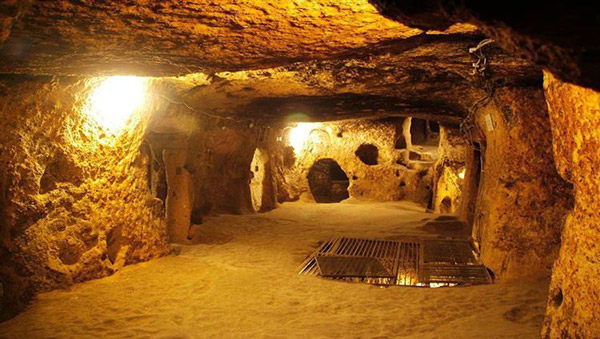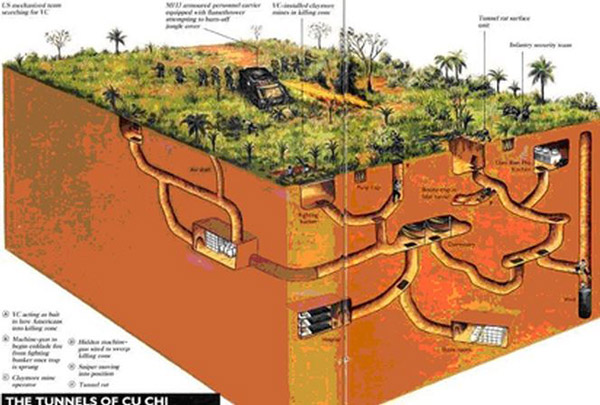Vietnam embraces countless historical sites to visit and learn about amazing and stimulating features regarding the country’s history, and one of them is Cu Chi Tunnels on the outskirts of Ho Chi Minh City. There are some things which will make you not believe and imagine during the Vietnam War. Let’s see!
Underground digging

Resilient people of all ages in Cu Chi dug the system of tunnels by hand and simple tools in the wartime. Each time the dark covered the sky, they started their work. They used simple holes to dig soft earth, but crowbars suffice to take the brunt of rock and hard ground. It is believed that excavated material and soil were brought out of the tunnels by plastic bags and bamboo baskets. One wonderful thing about this work was that all traces of excavating were always removed to keep the tunnels convert. In a lot of places of Cu Chi, rivers and bomb craters became dumping grounds. Despite the fact that tunnel excavation was close to the surface, bombing gradually forced Cu Chi people to dig deeper until it was safe enough to protect them. The network under the ground became more complex and expansive as dorms, meeting rooms, hospitals, bathrooms, workshops, and kitchens. Generally, most necessary facets of village life were found inside the tunnel network.
Tunnel levels

The tunnel network embraces four levels at different depths. While the first one, four meters deep is the place of traps, firing posts, and ventilation shafts, the second has sleeping chambers and kitchens. Additionally, the third level, which can withstand mortar attacks 6-7 meters from the surface provided aid stations, tunnel connections, and storage. The last level at the depth of 10 meters is for water sources. Wells were dug not only to provide drinking water, but also to lead to Saigon River. This waterway was also used as an escape route in several emergencies.
Ventilations
Because of the serious lack of oxygen underground, Vietnamese guerillas forced channeled air through dispersed holes on the earth. Due to that, the network could accommodate up to thousands of guerillas. Some evidences illustrate that the Viet Cong soldiers were once forced to stay underground for weeks. Living in the tunnels, you may understand that valuable air was rationed. Therefore, ventilation was surely the most significant factor in survival.
Communal living
The severe life in the tunnels as well as the wartime made people depend on a strong communal spirit. It was compassionate that the community sometimes fell in the terrible situation that they must eat grass, stale rice and even drink their own urine because of the food storage. All people of all ages no matter if they are male or female were showed how to fight in the tunnels. Nevertheless, their lives were not merely identified as combat and defense, but also included dance, song, and drama performances. It was possible to say that the life during this hard time was a picture of a gun in one hand, yet guitar in the other. The Vietnam guerillas managed to bring moments of happiness and bliss for their life while bombs were dropping ahead, forming and fostering community solidarity.
Recycling American weaponry
While the Vietnamese guerrillas were at the disadvantage in weaponry and technology, they were very smart to collect waste materials left by the Americans for recycling or repurposing. For instance, earnings from the shrapnel which was sold would be used to buy food and send it to the tunnel dwellers, or they repaired detonators and reused them in combat. Recycling American weaponry demonstrated that the Vietnamese people could adapt well to the difficult situations in their life.
Secret entrance ways
There were interesting stories about those secret entrance ways. The Vietnamese guerrillas would locate the enemy troops on the ground, then creep up and attack them from the closest passageway. The Vietnamese guerrillas often came from the edge of forests and tricked the Americans by their gunshots. The shots appeared from secret entrances hidden by the brush. Due to those entrance ways, the guerrillas could be safe under the enemy attack. With the coming of night, they sneaked out of many different tunnels surrounding American bases to steal weapon, ammunition, and food.
Narrow and dark tunnels
Are you wondering why the tunnels of the network are quite narrow while the Vietnamese guerillas must live in it for a long time? Actually, the narrow tunnels are exactly an advantage for the guerillas during the wartime. The Vietnamese people were fairly slim, so they could slip easily through small and narrow tunnels under the ground and even move easefully through tiny entrance ways. With such a tough structure, the Americans with big body would find it very difficult to go through and maybe get stuck in the narrow tunnels. Even smaller-bodied American soldiers called “Tunnel Rats”, well trained before could not overcome challenges under the ground in Cu Chi Tunnels.



